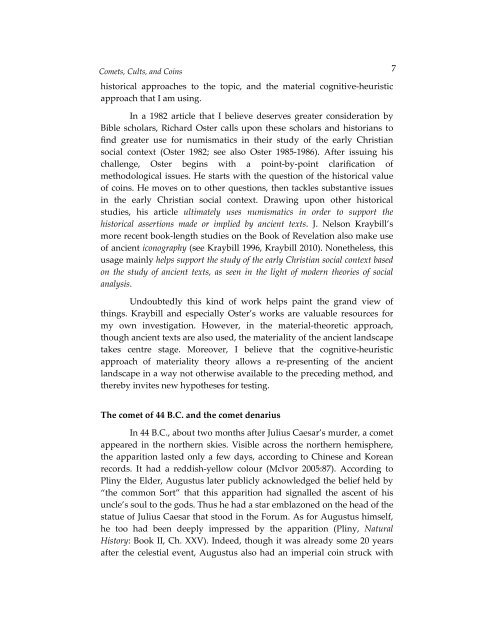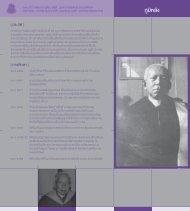Create successful ePaper yourself
Turn your PDF publications into a flip-book with our unique Google optimized e-Paper software.
Comets, Cults, and Coins 7historical approaches to the topic, and the material cognitive-heuristicapproach that I am using.In a 1982 article that I believe deserves greater consideration byBible scholars, Richard Oster calls upon these scholars and historians tofind greater use for numismatics in their study of the early Christiansocial context (Oster 1982; see also Oster 1985-1986). After issuing hischallenge, Oster begins with a point-by-point clarification ofmethodological issues. He starts with the question of the historical valueof coins. He moves on to other questions, then tackles substantive issuesin the early Christian social context. Drawing upon other historicalstudies, his article ultimately uses numismatics in order to support thehistorical assertions made or implied by ancient texts. J. Nelson Kraybill’smore recent book-length studies on the Book of Revelation also make useof ancient iconography (see Kraybill 1996, Kraybill 2010). Nonetheless, thisusage mainly helps support the study of the early Christian social context basedon the study of ancient texts, as seen in the light of modern theories of socialanalysis.Undoubtedly this kind of work helps paint the grand view ofthings. Kraybill and especially Oster’s works are valuable resources formy own investigation. However, in the material-theoretic approach,though ancient texts are also used, the materiality of the ancient landscapetakes centre stage. Moreover, I believe that the cognitive-heuristicapproach of materiality theory allows a re-presenting of the ancientlandscape in a way not otherwise available to the preceding method, andthereby invites new hypotheses for testing.The comet of 44 B.C. and the comet denariusIn 44 B.C., about two months after Julius Caesar’s murder, a cometappeared in the northern skies. Visible across the northern hemisphere,the apparition lasted only a few days, according to Chinese and Koreanrecords. It had a reddish-yellow colour (McIvor 2005:87). According toPliny the Elder, Augustus later publicly acknowledged the belief held by“the common Sort” that this apparition had signalled the ascent of hisuncle’s soul to the gods. Thus he had a star emblazoned on the head of thestatue of Julius Caesar that stood in the Forum. As for Augustus himself,he too had been deeply impressed by the apparition (Pliny, NaturalHistory: Book II, Ch. XXV). Indeed, though it was already some 20 yearsafter the celestial event, Augustus also had an imperial coin struck with



